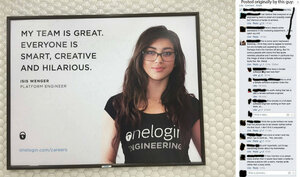#iLookLikeAnEngineer highlights problems and progress in tech diversity
A female platform engineer at a San Francisco-based IT company joins the fight against stereotypes in the tech industry.

Platform engineer Isis Wenger is featured in a recruitment ad for her employer, OneLogin in this photo taken from Ms. Wenger's blog post on Medium.com. Facebook comments about the ad prompted Wenger to launch an awareness campaign around gender bias in the tech industry.
Courtesy of Isis Wenger/Medium
A female engineer is taking a stand against bias in the tech industry.
After her photo for her company’s recruitment campaign drew sexist comments online, Isis Wenger, a platform engineer for San Francisco-based IT firm OneLogin, has launched an effort to fight stereotypes around how people in the tech industry are expected to look. The hashtag #iLookLikeAnEngineer has since become an outlet to showcase engineers’ varying genders, colors, and ages – and has drawn renewed attention to the conversation about diversity in technology.
“#iLookLikeAnEngineer is intentionally not gender-specific,” Ms. Wenger told TechCrunch. “External appearances and the number of X chromosomes a person has is hardly a measure of engineering ability. My goal is to help redefine ‘what an engineer should look like’ because I think that is a step towards eliminating sub-conscious bias towards diversity in tech.”
Wenger was one of five people asked to participate in a set of ads featuring OneLogin employees that went up around San Francisco. While some of the responses to Wenger's photo in particular were positive, Wenger and her company noted that other reactions epitomized existing biases in the industry.
“This is some weird haphazard branding,” one Facebook user wrote. “I think they want to appeal to women, but are probably just appealing to dudes. I’m curious [if] ... women in particular buy this image of what a female engineer looks like.”
Another added, “If their intention is to attract more women then it would have been better to choose a picture with a warm, friendly smile rather than a sexy smirk.”
In a blog post for Medium, Wenger responded:
News flash: this isn’t by any means an attempt to label “what female engineers look like.” This is literally just ME, an example of ONE engineer at OneLogin. The ad is supposed to be authentic ... and as far as I am concerned it is.
The tech industry has faced growing calls to increase diversity in the workplace. Companies such as Google, Apple, and Facebook, having acknowledged that their employees are mostly white and male, have pledged to do better.
“Silicon Valley is perhaps the world’s leading crucible of innovation,” The Christian Science Monitor reported in May.
But it is a man’s world. While women make up roughly 50 percent of the workforce in the United States, their numbers in the tech industry come in at around 25 percent. In senior positions, it is 17 percent, and 12 percent for executive positions.
High-profile lawsuits filed by women in top tech companies have also highlighted bias issues in the work environment.
But as much as Wenger’s case highlights industry problems, it also showcases progress. #iLookLikeAnEngineer has led users to post their own photos in an effort to exhibit the many faces of the tech workforce.
“I didn’t want or ask for any of this attention, but if I can use this to put a spotlight on gender issues in tech, I consider that to be at least one win,” Wenger wrote.

